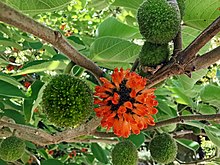Broussonetia: Difference between revisions
Content deleted Content added
m →top: rearranged templates; other uses first / About / Dablink to be first; before short desc |
m No geographic categories at genus level, unless endemic. |
||
| Line 37: | Line 37: | ||
[[Category:Moraceae]] |
[[Category:Moraceae]] |
||
[[Category:Flora of East Asia]] |
|||
[[Category:Flora of China]] |
|||
[[Category:Flora of Japan]] |
|||
[[Category:Flora of Korea]] |
|||
[[Category:Trees of Asia]] |
|||
[[Category:Moraceae genera]] |
[[Category:Moraceae genera]] |
||
[[Category:Taxa named by Charles Louis L'Héritier de Brutelle]] |
[[Category:Taxa named by Charles Louis L'Héritier de Brutelle]] |
||
{{tree-stub}} |
|||
{{Moraceae-stub}} |
{{Moraceae-stub}} |
||
Revision as of 22:33, 14 April 2020
| Broussonetia | |
|---|---|

| |
| Broussonetia papyrifera (paper mulberry) | |
| Scientific classification | |
| Kingdom: | |
| (unranked): | |
| (unranked): | |
| (unranked): | |
| Order: | |
| Family: | |
| Tribe: | |
| Genus: | Broussonetia L’Hér. ex Vent.
|
| Species | |
|
Broussonetia kaempferi | |
Broussonetia is a genus of four species of trees in the family Moraceae, native to eastern Asia. One of these is the paper mulberry (Broussonetia papyrifera), whose bark fiber is used to make high-quality paper in China, Korea, and Japan. This species has been widely introduced and has become invasive in some areas.
Fossil record
Five fossil fruits of †Broussonetia pygmaea have been extracted from borehole samples of the Middle Miocene freshwater deposits in Nowy Sacz Basin, West Carpathians, Poland.[2]
References
- ^ "Broussonetia L'Hér. ex Vent". Germplasm Resources Information Network. United States Department of Agriculture. 2009-01-16. Archived from the original on 2009-01-14. Retrieved 2009-03-11.
- ^ Łańcucka-Środoniowa M.: Macroscopic plant remains from the freshwater Miocene of the Nowy Sącz Basin (West Carpathians, Poland) [Szczątki makroskopowe roślin z miocenu słodkowodnego Kotliny Sądeckiej (Karpaty Zachodnie, Polska)]. Acta Palaeobotanica 1979 20 (1): 3-117.
External links
 Media related to Broussonetia at Wikimedia Commons
Media related to Broussonetia at Wikimedia Commons- Flora of China: Broussonetia
